Are you looking to sell digital products through your WordPress website? Selling digital downloads or products can be a great way to monetize your website and reach a wider audience.
WordPress makes it easy to sell digital products online, whether you’re selling eBooks, courses, or software.
This blog post will walk you through setting up a digital product store on WordPress, including choosing the right plugin, setting up payment gateways, and managing your products.
By the end of this post, you’ll have the steps to start selling digital products using your WordPress website.
What are the steps to sell digital products using WordPress?
Are you ready to build a digital product empire on WordPress? Excellent! Let’s get started with step one:
Step 1: Web Hosting and Domain Name.

Before you can start selling digital products on WordPress, you’ll need a reliable web hosting service to host your website.
There are many options, each with its own set of features and pricing plans. It’s important to research and choose a hosting provider that fits your needs and budget.
When choosing a web host, some things to consider include:
- Disk space and bandwidth: How much storage space and bandwidth will you need to host your website and digital products? Make sure you choose a hosting plan with enough resources to support your business.
- Uptime: Look for a host with a high uptime guarantee, typically 99% or higher. This ensures that your website will be available to customers when they need it.
- Customer support: Choose a hosting provider with a track record of excellent customer support. You never know when you might need help with something, and it’s important to have a team of experts available to assist you.
Once you’ve chosen a web host, it’s time to buy a domain name for your store. This is the URL that people will type into their browser to access your site.
Choose a short, memorable domain that accurately reflects your brand.
Step 2: Install and Configure WordPress.
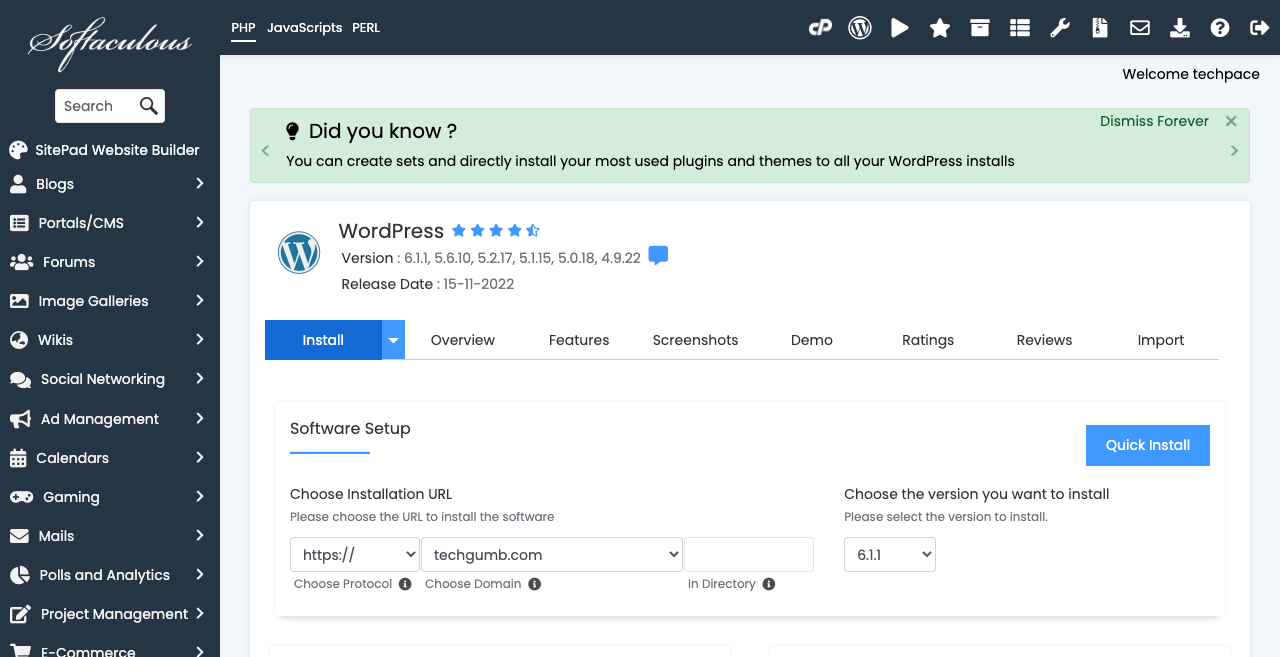
Now that you have a web host and a domain, it’s time to install and configure WordPress. WordPress is a CMS software that will power your website and allow you to manage your content and settings.
Most hosting providers offer one-click WordPress installs that make the process a breeze. Simply log into your hosting account, click the WordPress install button, and follow the prompts.
Once WordPress is installed, you’ll need to customize your site’s appearance and settings to suit your needs. This includes choosing a theme, adding pages and posts, and setting up your site’s navigation menu.
There are tens of thousands of both free and premium WordPress theme options to choose from, so take your time and find one that fits your brand and aesthetic.
Step 3: Select an eCommerce Plugin.
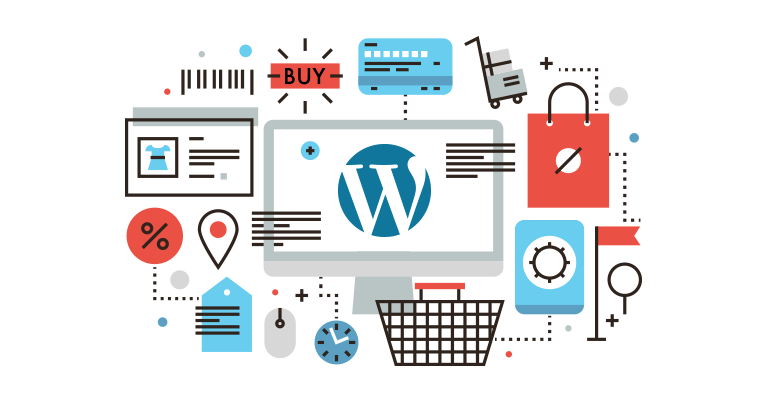
Image source: Hostgator
To sell digital products on WordPress, you’ll need an eCommerce plugin to manage payments, inventory, taxes, and shipping. There are many options to choose from, each offering its own set of features and pricing plans. Some popular choices include WooCommerce, Easy Digital Downloads, and Shopify.
Take some time to research the different options and choose the plugin that best fits your needs.
Remember that some plugins require additional add-ons or extensions to enable certain features. Be sure to factor in these extra costs when deciding which plugin to use.
Step 4: Add Digital Products to the Store.
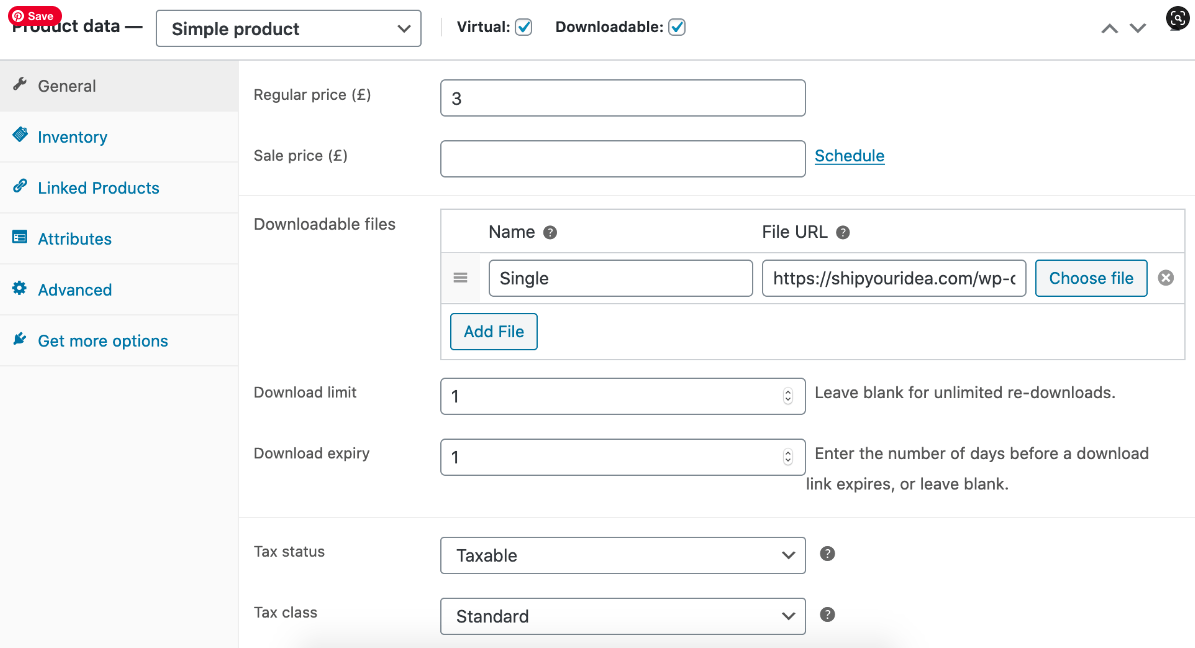
You must create individual pages for each product to add digital products to your online store. These pages should include a detailed description of the product and high-quality images showcasing it. You should also have pricing information on these pages.
When creating your product pages, provide as much information as possible about each product to help customers understand what they are purchasing and make informed decisions. Consider offering different pricing tiers or bundle packages to give customers more options.
For example, you could offer a basic product version at a lower price point and a premium version with additional features at a higher price point.
Step 5: Create Product Pages.
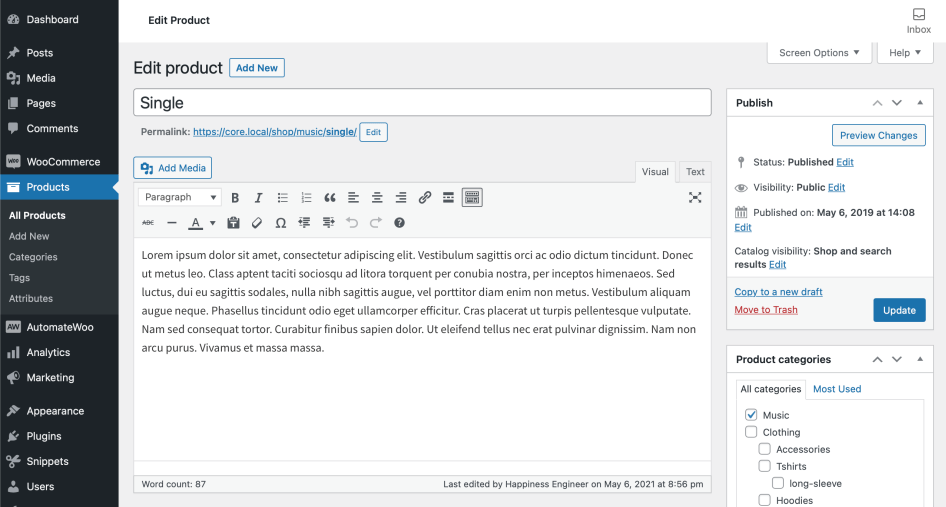
To create product pages for your digital products, you will need to provide potential customers with all the information they need to make an informed purchase decision, including descriptions, images, and pricing information for each product.
To create effective product pages, you should include detailed descriptions of your products that clearly outline their features, benefits, and other relevant information.
High-quality images are also essential for showcasing your products and helping customers visualize their purchases.
In addition to descriptions and images, you should include pricing information on your product pages to help customers understand the cost of each product and make it super easier for them to compare prices with other products.
Consider including customer reviews or ratings on your product pages to build trust and credibility with potential customers, as they can see what other people who have purchased your products have to say about them.
Step 6: Set Up Payment Methods.
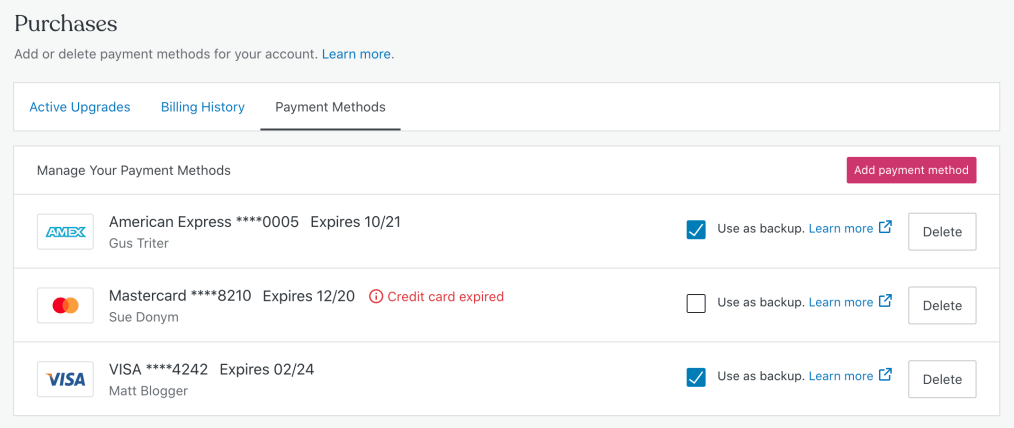
Now that you’ve added your digital products to the store and created product pages, it’s time to set up payment methods to accept customer payments.
There are several payment gateways available, including PayPal and Stripe. Both options are popular for online stores, offering a range of features and pricing plans to suit different business needs.
To set up a payment gateway, you’ll need to sign up for an account and follow the instructions provided by the gateway provider. This typically involves entering your business information and integrating the payment gateway into your WordPress website.
Test the payment gateway to ensure it’s working properly before launching your store.
Step 7: Promote Your Store.

Image source: Wedevs
Now that your store is running, it’s time to promote it and drive traffic to your site. Social media platforms like Twitter, Pinterest, and Facebook are great places to start, as they allow you to reach a large audience at little to no cost.
Consider creating social media accounts for your business and sharing updates about your products, special offers, and other relevant information.
You can also consider running paid Facebook or Google advertising campaigns to target specific audiences or collaborating with influencers to get the word out.
Step 8: Monitor Customer Feedback and Reviews.

Monitoring customer feedback and reviews are an important step in improving the customer experience and ensuring the success of your digital product business.
By paying attention to what your customers say, you can identify any issues or areas for improvement and take steps to address them.
To effectively monitor customer feedback, you should regularly review any customer inquiries or complaints you receive through your online store or other social media, or email channels.
It’s important to respond promptly and professionally to any customer inquiries or complaints, as this can help build trust and foster loyalty.
If you receive negative feedback or reviews, it’s important to take them seriously and work to address any issues that may have caused them. This may involve making changes to your products or processes or simply providing better customer service.
Why use WordPress to sell digital products?
If you are asking yourself, why WordPress? I feel you!
WordPress is a powerful and flexible content management system that makes creating and managing an online store easy. Here are three key reasons why WordPress is an excellent choice for selling digital products:
WordPress is Easy to Use
One of the biggest benefits of using WordPress to sell digital products is that it’s extremely easy to use. Whether you’re a tech-savvy developer or a complete beginner, you’ll find that WordPress is intuitive and user-friendly.
It has a simple, straightforward dashboard that allows you to manage your products, orders, and customers easily. Plus, hundreds of helpful tutorials and resources are available to help you get up and running quickly.
WordPress is SEO-Friendly
SEO or Search Engine Optimization is essential for any online business. It helps ensure that your website ranks highly in search engine results, making it easier for customers to find your products.
Fortunately, WordPress is highly SEO-friendly, so optimizing your website for search engines is easy. It has built-in features like clean, SEO-friendly URLs and the ability to add custom tags and metadata to your pages.
Plus, there are numerous plugins available that can help you optimize your website even further.
The Largest CMS on the Market
WordPress is the largest content management system on the market, powering millions of websites worldwide. This means it’s a well-established and reliable platform you can trust to power your online store.
It has a large and active community of developers, designers, and users who constantly create new themes, plugins, and resources to help you succeed.
What To Consider When Creating Your WordPress store
If you’re creating a WordPress website to sell digital products, there are a few key considerations you’ll want to keep in mind. Here are three things to consider when creating your WordPress website:
Your Product Should Be Downloadable
When selling digital products, it’s important to ensure that your products are easily downloadable by your customers. There are three different ways to do this:
- Offer a direct download: This is the most straightforward option. Simply allow your customers to download the product directly from your website after they’ve made a purchase.
- Use a third-party file hosting service: If you’re selling large files or expect to have a lot of traffic, consider using a third-party file hosting service such as Dropbox or Google Drive. This can help ensure that your website is manageable with traffic and that your customers can easily download their purchases.
- Use a plugin: Several WordPress plugins can help you manage digital downloads, such as Easy Digital Downloads or WooCommerce. These plugins offer features such as automatic file delivery, download tracking, and more.
Work Backwards from Your Desired Price
When setting the price for your digital products, it’s important to consider your costs and desired profit margin. One helpful strategy is to work backward from your desired price to determine how much you need to sell to break even and start making a profit.
First, calculate your total costs, including any expenses related to creating and marketing your products, as well as any ongoing expenses such as web hosting and payment processing fees.
Then, divide this number by your desired profit margin to determine your minimum selling price. For example, if your total costs are $100 and you want a 20% profit margin, you’ll need to sell your product for at least $125 to break even.
By working backward from your desired price, you can ensure that you’re pricing your products in a sustainable and profitable way for your business.
An eCommerce Theme and Plugin
When creating your WordPress website, it’s important to choose a theme and plugin that supports eCommerce. Many options are available, each with its own features and pricing plans.
Some popular eCommerce themes include Astra, ShopIsle, and Divi, while popular eCommerce plugins include WooCommerce, Easy Digital Downloads, and Shopify.
Take some time to research the different options and choose the theme and plugin that best fits your needs.
Keep in mind that some themes and plugins may require additional add-ons or extensions to enable certain features.
Security
Security is crucial when creating any online store, and it’s especially important when selling digital products. Hackers and cybercriminals are always looking for vulnerable websites to exploit, and you don’t want your store to be an easy target.
To ensure the security of your WordPress website, it’s important to take a few precautions:
- Use strong, unique passwords for all of your accounts.
- Keep your WordPress software and any plugins or themes up to date.
- Use a security plugin to protect your site from malware and other threats.
- Use SSL encryption to secure the data transmitted between your website and your customers.
Following these best practices can help protect your website and your customer’s personal and financial information.
How To Market Digital Products on WordPress?
So you created your WordPress ecommerce website, added products, and set up a payment gateway; now it’s time to promote your products. Here are seven effective marketing strategies to consider:
Cross-Promote with Other Products
One effective way to market your digital products on WordPress is by cross-promoting them with other products.
For example, if you sell a course on how to start a business, you could offer a discount or bonus to customers who purchase your course and a related product, such as a book on marketing or a software tool.
By cross promoting your products, you can tap into the customer base of other products and increase the chances that potential customers will discover your products.
Run a Prize Campaign (aka Giveaway)
Who doesn’t love a good prize? Consider running a prize campaign or giveaway to attract attention to your digital products. This can be as simple as offering a free copy of your product to a randomly selected winner or offering a bundle of products as the prize.
To enter the giveaway, you can require participants to follow your social media accounts, sign up for your email list, or share the giveaway with their followers. This can help you attract new followers and build buzz around your products.
Share With Friends, Family, and Followers
Don’t underestimate the power of word-of-mouth marketing. Share your digital products with your friends, family, and followers to get the word out about your business.
You can share your products on your social media accounts, email lists, and personal connections.
Use Hashtags to Attract Attention
Hashtags are a great way to attract attention to your digital products on social media.
Use relevant hashtags when sharing your products on platforms like Twitter and Instagram to increase potential customers’ chances of discovering them.
Use Your Existing Customer Base
Your existing customers can be a valuable source of referrals and repeat business, so nurture those relationships.
Consider offering incentives for customers who refer their friends and family to your products or special discounts and promotions to repeat customers.
Create an Email List
An email list is a valuable marketing asset for any online business and is especially important for digital product sellers.
Use your email list to stay in touch with your customers and promote your products.
You can send your subscribers newsletters, special offers, and other relevant information to keep them engaged and informed.
Create a Product Launch Sequence
When launching a new digital product, creating a well-planned product launch sequence is important to build buzz and attract customers. This can involve a series of emails, social media posts, and other marketing efforts leading up to the launch.
Consider offering early bird discounts or special bonuses to customers who pre-order your product or creating a sense of urgency by offering a limited time.
Sell digital products using WordPress FAQs.
How Do I Add a Product to My WordPress Site?
To add a product to your WordPress site, you’ll need to use an eCommerce plugin such as WooCommerce or Easy Digital Downloads.
Once you’ve installed and activated the plugin, you can follow the instructions provided by the plugin developer to add your products to the store. This typically involves creating product pages with descriptions, images, and pricing information.
How Do I Add a Product to an Existing Page?
To add a product to an existing page on your WordPress site, you’ll need to use shortcodes provided by your eCommerce plugin.
These shortcodes allow you to insert product information and buy buttons into any page or post on your site.
To add a product to an existing page, open the page in the WordPress editor and use the appropriate shortcodes to insert the product information and buy button.
For example, the WooCommerce plugin provides shortcodes such as [product_page] and [add_to_cart] that you can use to display products and add buy buttons to your pages.
How Do I Offer Discounts or Promotional Codes?
Most eCommerce plugins for WordPress can create discounts or promotional codes for your products. You’ll need to use the relevant feature provided by your plugin to offer discounts or promotional codes.
For example, the WooCommerce plugin allows you to create coupons you can offer customers to redeem at checkout. You can specify the discount amount, the products, or categories that the coupon applies to, and any other relevant details.
How Do I Create a Shopping Cart in WordPress?
To create a shopping cart in WordPress, you’ll need to use an eCommerce plugin that provides this feature.
Most eCommerce plugins, such as WooCommerce and Easy Digital Downloads, offer a built-in shopping cart feature that allows customers.
Wrap up.
In conclusion, selling digital products on WordPress is a great way to reach a global audience and turn your passion into a thriving business. Following the steps outlined in this blog post, you can set up your online store and start selling digital products in no time.
To recap:
Remember to choose a reliable web hosting service, buy an attractive domain name, and install and configure WordPress.
Select an eCommerce plugin to manage payments, inventory, taxes, and shipping; add your digital products to the store.
Create product pages with descriptions, images, and pricing information, set up payment methods such as PayPal or Stripe, promote your store on social media platforms like Twitter and Facebook, and monitor customer feedback and reviews to improve the customer service experience.
You can turn your WordPress website into a thriving digital product empire with effort and savvy marketing tactics.
So, if you’re ready to start selling digital products, give WordPress a try – you won’t be disappointed.




